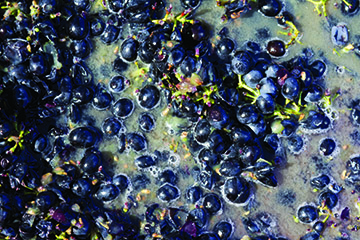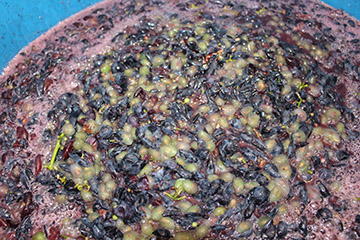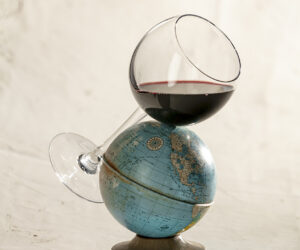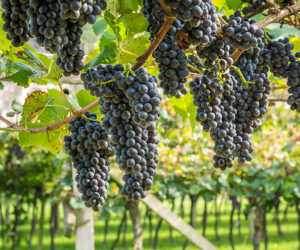
“Friends don’t let friends drink white Zinfandel.” Seems like an awfully silly way to evaluate one’s loyalty, but this saying that has popped up in wine-consuming circles for years speaks to the wine world’s palpable fatigue with the sweet, mass-produced blush wines that dominated liquor store shelves in the 80s and 90s. Once a cultural touchstone, these products overshadowed their drier counterparts and colored public perception of what pink wines could be.
Though it was hidden in the background for a few tough decades, dry rosé eventually worked its way back into the conversation, and has quickly become a favorite of a new generation of winemakers and wine
drinkers alike.
In light of its recent renaissance, it may be tempting to think of dry rosé as a younger, less-proven style, but the fact is dry rosés have likely been around as long as wine itself. Prior to the advent of more familiar red winemaking techniques, lightly extracted rosé wines were prized for their drinkability and were long preferred to their darker counterparts, which required extended aging. Even Bordeaux, a region celebrated today for its rich red wines, came to prominence as far back as the Middle Ages producing “clairet,” a dark-hued rosé.
Aside from Bordeaux, the Old World regions most known for dry rosé production are Provence and Tavel, both in southeast France. Provençal rosés, generally produced via direct-pressing or cold maceration, are best drunk young and prized for their sprightly acidity and herbal aromatics. Tavel rosés, on the other hand, are most often vinified via co-fermentation of red and white grape varieties or the saignée method — bleeding juice off of must destined for red wine fermentation — and are thereby more structured and age-worthy. Provence and Tavel may be the Old World’s most notable rosé producers, but the phenomenon is hardly limited to France: Italian rosatos, Spanish rosados, and German roseweins all merit mention in this highly popular category.
With the explosive success of dry rosé, it’s natural that New World winemakers would get in on the action. Long Island has positioned itself as the vanguard of North American pink wines, producing exquisite dry rosés that wouldn’t seem at all out-of-place if tasted blind against their Provençal counterparts. Even in California, ground zero for the sweet blush craze of the 80s, this drier style is making waves: Some forward-thinking winemakers are even producing them from Zinfandel!
Why Make a Dry Rosé?
Aside from its iconic appealing pink hue, the most notable characteristic of dry rosé is its versatility. The vast range of flavor, texture, and aromatic profiles that may be achieved in this category allows for wines that are excellent in a wide variety of seasonal, situational, and culinary contexts. This flexibility extends to the production side of the equation as well; dry rosé can be made from an array of grape varieties and techniques, and is accessible to winemakers of all skill and experience levels.
One somewhat underreported attribute of dry rosé is its utility as a fallback plan in seasons and situations where grape growing and winemaking conditions are challenging. Because of their limited phenolic extraction, direct-pressed or lightly macerated dry rosés are excellent ways to use red grapes in vintages and vineyards where environmental conditions may impede phenolic ripening. Richer, saignée-based rosé wines may be produced as a byproduct of red wine fermentations where more concentration is desired. Co-fermentation or blending post-fermentation may also be effective methods of utilizing less-than-optimal fruit or repurposing red or white wines that are underwhelming on their own.
Whether made with careful intent or pursued as a response to the sort of challenging circumstances with which all winemakers are occasionally confronted, the ability to make consistently compelling wines under a variety of conditions is reason enough for any amateur winemaker to add dry rosé to their repertoire.

How to Make Dry Rosé
The first question winemakers new to the game will ask themselves is where to get started in producing a dry rosé. In a typical how-to article, the next logical step would be a discussion of grape variety selection and ideal fruit parameters, but the variability of rosé production methods means that there aren’t one-size-fits-all solutions for either of these inputs. As such, it makes a bit more sense to first discuss each of the different production techniques, elaborating on the most suitable grape varieties and harvest parameters for each.

Direct Press and Cold Maceration
Popular in Provence, France, the direct press or cold maceration rosé production method results in fresh, pale pink wines, primed for drinking young. In this protocol, whole red grapes are chilled prior to crushing, which limits extraction of texturally rough phenolic compounds during the maceration step. Once the fruit has been sufficiently chilled, it is crushed either to the press or a holding vessel. The must is then held for up to 24 hours prior to pressing. The amount of time the must is allowed to soak with skins is at the discretion of the winemaker and has a direct impact on the color, aroma, and texture of the resulting wine, as extended maceration time will amplify the amount of pigments, aromatic precursors, and tannins extracted.
Direct pressing (no soak time whatsoever) may be employed with color-rich grape varieties in order to maintain a classic, pale hue, but it may also be used to produce vin gris — an ultra-pale form of rosé that is often indistinguishable from white wine. Darker grape varieties like Marquette, Noiret, Vincent, Chambourcin, Saperavi, and Alicante Bouschet have such concentrated pigment that extended soak time often makes for wines that more closely resemble reds — pressing directly following crush limits extraction and allows for the production of rosés with the familiar pink coloration. Less pigmented varieties like Pinot Noir or Lemberger may be used to produce vin gris — though whole-cluster pressing is advised if that’s the goal.
Some cold maceration may be applied with grape varieties where color isn’t as concentrated or more textural and aromatic complexity is desired. In this case, the soak time may be adjusted to suit the stylistic aims of the finished product. For cultivars with richer phenolic profiles, like Cabernet Sauvignon or Tempranillo, a shorter maceration interval of less than 12 hours can be used to keep the resultant wine lean and fresh. For lighter varieties like Pinot Noir or where some herbal complexity is desired — as with the classic Provençal varieties Grenache and Mourvèdre — a longer maceration of greater than 12 hours may be desired.
When sourcing fruit for direct press or cold maceration, a few key harvest parameters must be considered. Given the fresher, more acid-driven profile of wines produced in this style, it may be advantageous to harvest the fruit a few weeks prior to phenological ripeness. This allows the winemaker to prioritize bright acidity and lower potential alcohol, with the foreknowledge that unpleasant, underripe phenolic compounds will be largely excluded. In addition to fruit chemistry, attention must be paid to fruit cleanliness. Fruit rots like Botrytis are equipped with a host of polyphenol oxidase enzymes that are capable of degrading pigment compounds in wine — leaving the winemaker with a product that is often more orange than pink.
Saignée
French for “to bleed,” saignée is a technique by which liquid is removed from a red wine fermentation in order to increase the ratio of skin-to-liquid in the fermentation vessel, allowing for more concentration in the resultant red wine. The removed fraction, however, may be fermented to produce rich, age-worthy, dry rosés. In this method, red grapes are crushed into a fermentation vessel where they’ll soak for several hours or even days prior to the removal of some juice — generally 10–20% of the total volume. Unlike the cold maceration method, it may be advantageous for the fermentation to start prior to the bleeding process, as the natural capping that occurs in red wine fermentation actually serves to streamline the separation of liquid from pulp. If you do choose to pursue a post-inoculation saignée, be aware that it places some limits on the amount of control you’ll have over the process. The wine will already be in the throes of fermentation, so techniques like cold settling your juice, adjusting its composition, or inoculating with a different yeast strain than your red ferment will become difficult if
not impossible.
The separated bleed wine produced via saignée may be fermented on its own — perfect for lighter varieties like Pinot Noir or red hybrids like Marechal Foch — or blended into white juice or wine, an excellent use of the drained fraction from richer reds like Cabernet Sauvignon or Syrah.
When working in the saignée tradition, the harvest parameters should be scaled to the goals of the desired red wine more than the rosé fraction. In this case, winemakers ought to prioritize phenological ripeness over acidity, as the concentration process will amplify the phenolic and aromatic content of the finished red wine. If more acid or a fresher flavor profile is desired of the rosé portion, it can always be blended with a fresher, more acid-driven wine in order to advance that aim. As always, working with clean fruit will increase the chances of success, as the presence of fungus or sour rot on the grapes may lead to volatile acidity or other forms of bacterial spoilage in both the red and bled fractions.

Co-Fermentation and Blending
Maybe the simplest and most accessible way to produce dry rosé is by co-fermentation or post-fermentation blending of red and white grape varieties. This technique doesn’t require intervention at any of the fruit processing steps, so it’s a viable option for aspiring pink winemakers who haven’t invested in crush equipment. In co-fermentation, red and white grape varieties may be processed together or blended post-pressing/draining, then allowed to ferment together, producing wine with the classic rosé color.
This co-fermentation strategy is popular in France’s other rosé destination, Tavel, where saignée is often blended with less extracted rosé or even white grape juice prior to fermentation in order to produce rich, age-worthy pink wines.
In my experience, co-fermentation is an excellent way to add more complex, floral dimensions to dry rosé, by leveraging aromatic white grape varieties like Traminette, Grüner Veltliner, or Gewürztraminer as blending bases. There are no hard and fast rules about the ratio of white to red juice in this method, but the white portion ought to make up the bulk of the wine’s volume, as a little bit of red can go a long way.
Co-fermentation is also an excellent way to use heavier press fractions of white wine juice: The rounder, more phenolic heavy-press juice that may not be ideal for a varietal Riesling or Chardonnay can be used to make compelling rosé with the addition of a little bit of Cabernet Franc or Marquette. Blending may also be performed post-fermentation, but that can be challenging as finished red and white wines are often more difficult to harmonize. As is often the case in winemaking, early intervention tends toward more integrated, soulful wines; blending for rosé is no exception.
Fermentation Parameters
Once the juice is ready for fermentation — owing its pink color to maceration, saignée, or blending — the ideal vinification parameters closely resemble those for white wines. Fermenting rosés at cooler temperatures (55–70 ºF/13–21 °C) ensures the preservation of fresh fruit aromatic profiles. A variety of yeast strains may be chosen to flesh out the desired style of the finished product, but strains that are recommended for use in both red and white wine ferments are often the most effective for producing dry rosé. Lallemand’s Rhône 4600, ICV-GRE, and Anchor’s Exotics Mosaic are a few of my personal favorites as they produce wines with vibrant, complex aromatic profiles and textural depth. As with any fermentation, proper attention to yeast nutrition and oxygen saturation go a long way toward maintaining aromatic freshness, limiting off-odors, and preventing stuck fermentations — the goal is to produce dry rosé, after all.
Malolactic fermentation can be an effective tool for shaping acid profiles and promoting richness in rosé wines, where desired. For wines produced in the saignée method, where concentration of phenolic compounds is higher, some acid management may be necessary to smooth out rough textural edges. If malolactic fermentation is pursued for this purpose, it may behoove the winemaker to select a bacterial strain with limited diacetyl production, as the buttery aromatic compound can intrude on some of the more delicate elements of these wines. Lallemand’s VP41 is a stellar selection for this task as it is both robust (not always a given for malolactic bacteria) and respectful of fruit and herbal aromatics.
Aging Considerations
Aging protocols for dry rosés are as varied as the wines themselves — the stylistic trajectories of wines produced from each of the previously enumerated methods require different aging times, vessels, and treatments. Though much of rosé production closely resembles white winemaking, there are some unique considerations that must be weighed in order to properly respect its trademark pink hue.
For rosés where freshness is prioritized — as with those produced from direct pressing, cold maceration, and white-heavy blending — a quicker-to-bottle approach is desirable. These methods limit phenolic extraction, meaning that the resultant rosés are not only less protected against oxidation, but also not tannic enough to require long-term bulk aging. Wines produced in this style benefit from early racking to limit lees contact and bulk storage in neutral, reductive containers like well-topped glass carboys — this preserves aromatic freshness and lively acidity. It’s not uncommon for dry rosé to be one of the first wines of a vintage to be bottled; the typical turnaround from harvest to bottling is generally in the range of 3–5 months, timing them perfectly for spring sipping.
Richer saignée or co-fermented rosés may require a bit more bulk aging than their cold macerated counterparts. The increased phenolic content of these wines often leads to wines that are awkward in their youth — clunky in both texture and aroma. In these cases, extended lees contact may be an effective method of harmonizing acid and tannin. Additionally, bulk aging in breathable vessels like FlexTanks or oak barrels may help to round out some of the rougher tannic edges, though the winemaker is cautioned to limit the use of newer oak as it is likely to contribute tannin and intrude on delicate aromatics.
The unique chemical composition of dry rosé wine requires that some care must be taken to preserve its color. In red wines, red-pigmented anthocyanin molecules stabilize themselves to tannins, creating a color that persists against the myriad treatments and chemical changes that may occur over the lives of those wines. In rosés, however, the limited concentration of tannin leaves unstable anthocyanins, sensitive to fining, filtration, and sulfite additions. If the winemaker chooses to employ fining or filtration in the production of dry rosé, they should be aware that color will be lost at each of these steps: Limiting their use where possible is the clearest way to preserve it. Unstabilized anthocyanins also respond dramatically to the addition of sulfites — a bleaching effect that is enough to send even the most experienced winemakers into a panic. However, this bleaching is reversible and the pink coloration is likely to return in the days and weeks following the addition.
Conclusions
With unmatched versatility and a multitude of production possibilities, it’s easy to see why dry rosé has captured the imaginations of winemakers and wine drinkers alike. Whether it results from careful planning or a clever response to unexpected challenges, rosé is a category open to winemakers with a variety of experience levels and stylistic preferences. Crafting a dry rosé of your own gives you the opportunity to participate in an awakening to pink wines as more than just the dime-a-dozen, sweet offerings of decades past. Dry rosé is having a moment, isn’t it about time you seized it?







